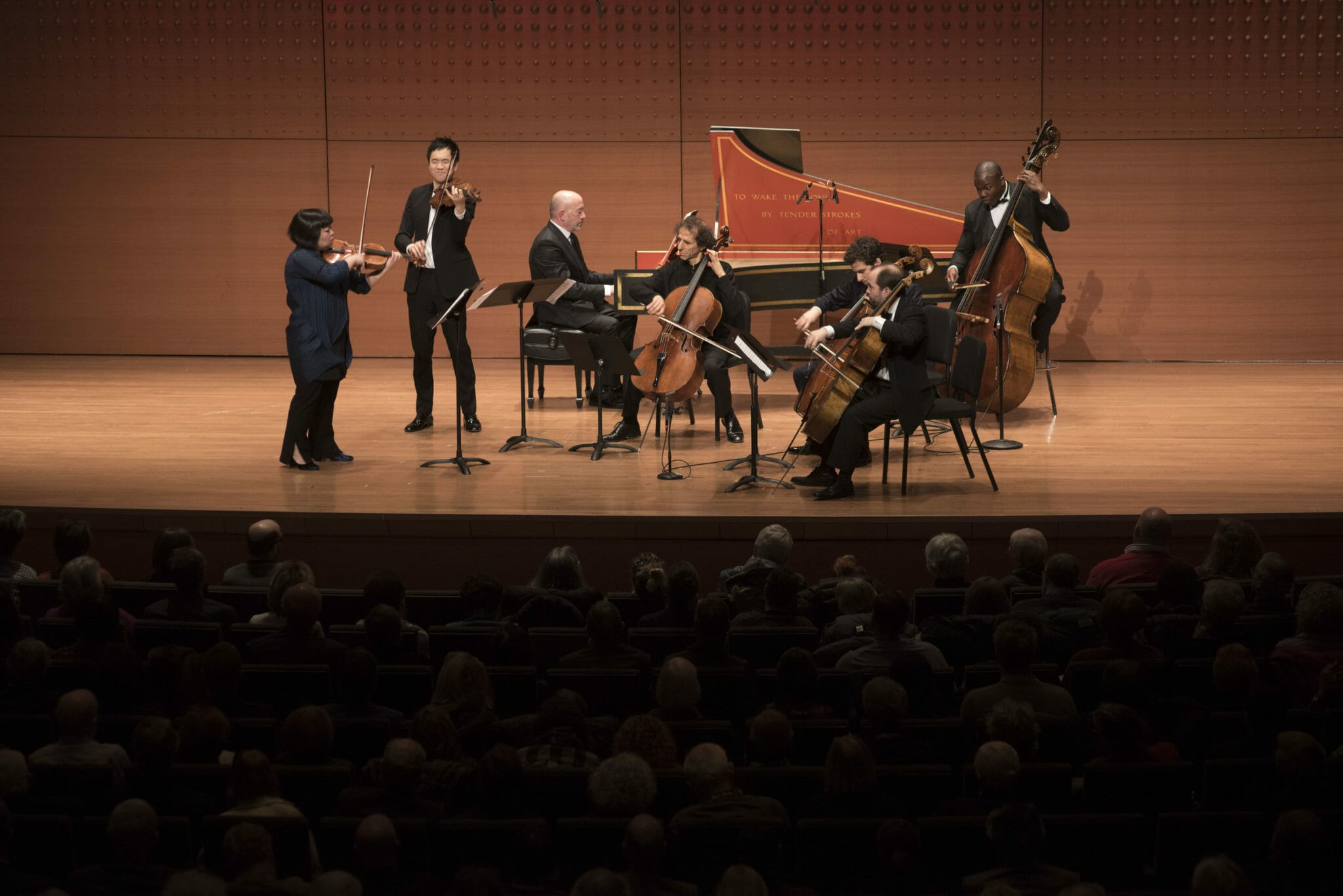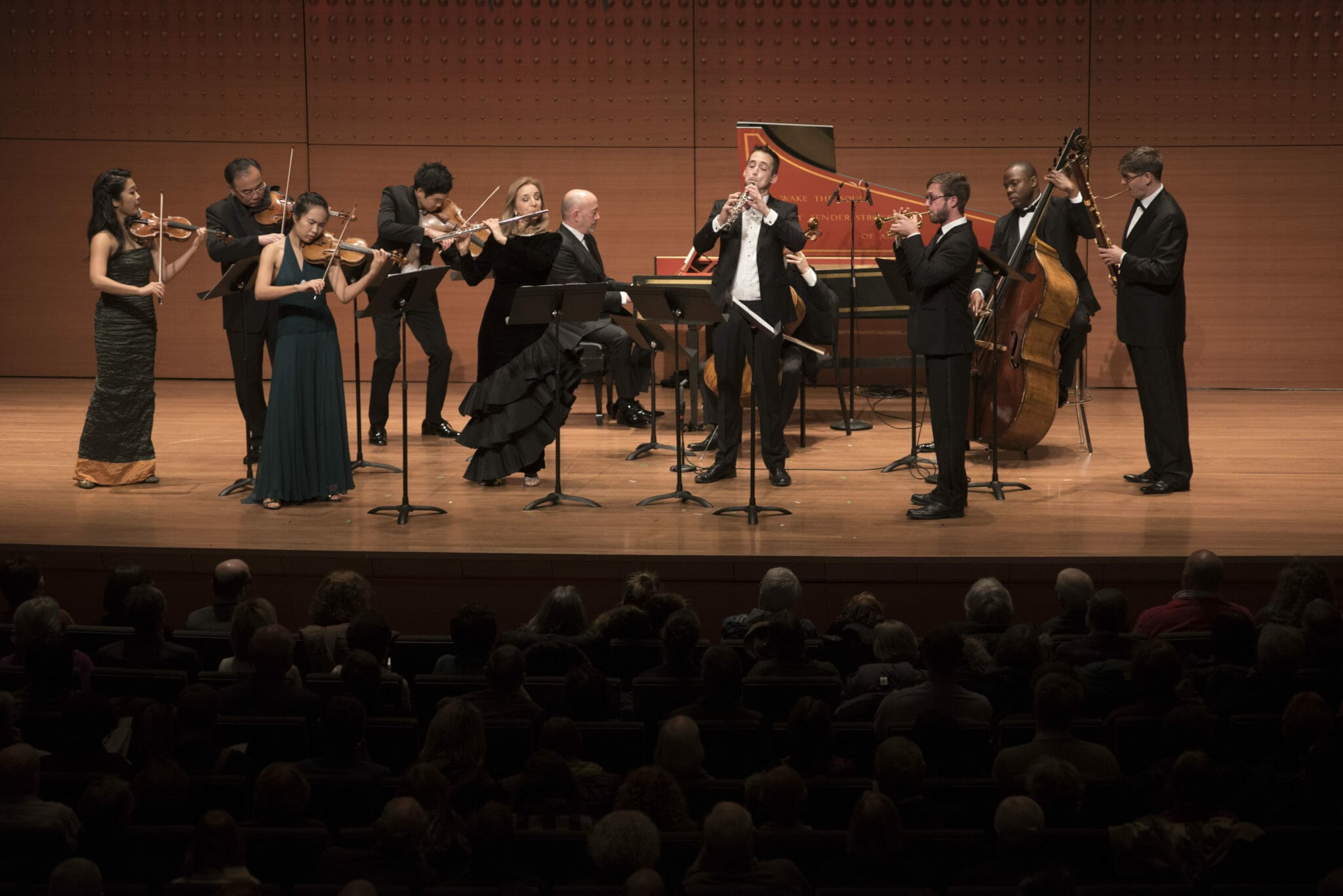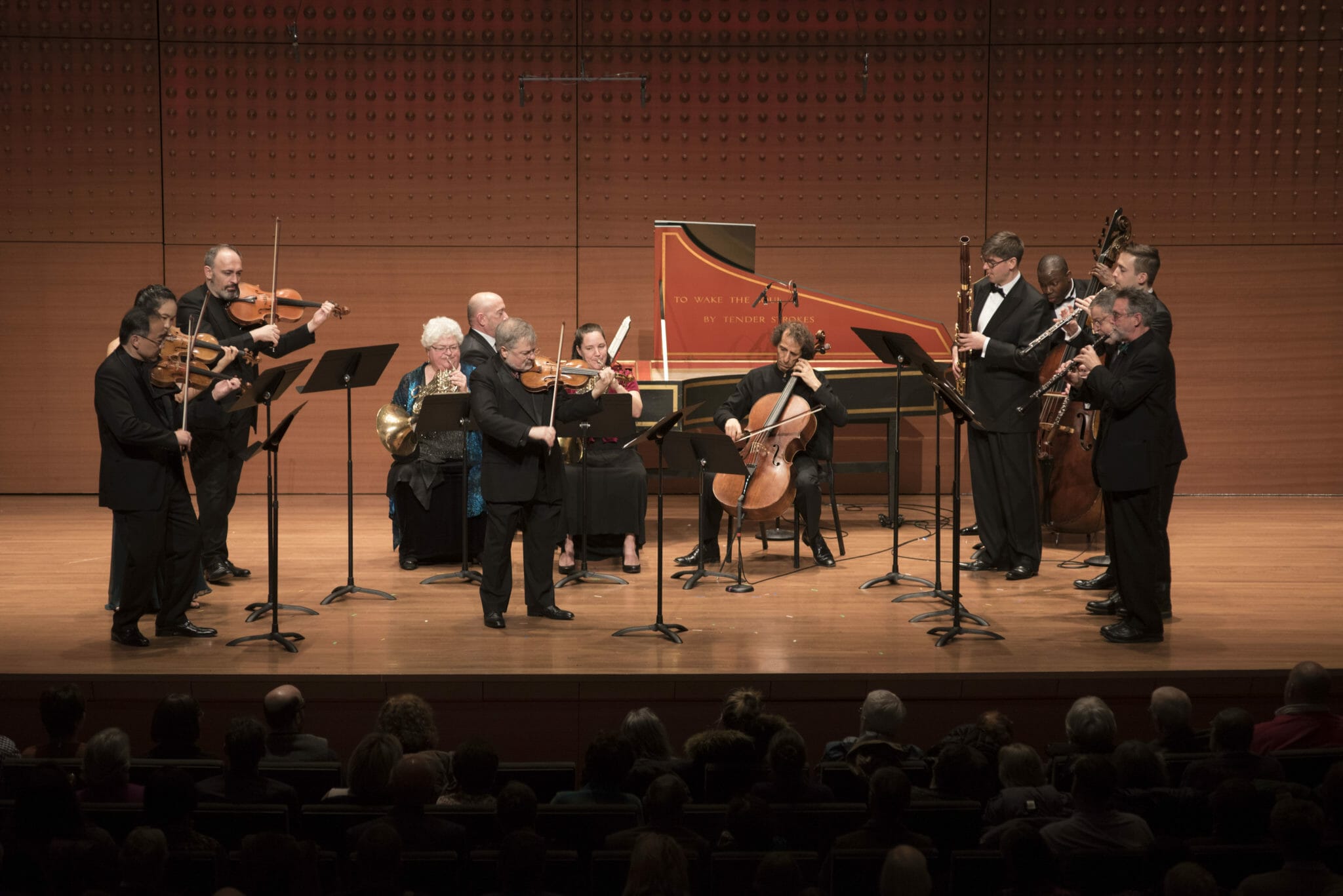HARRIS THEATER HOSTS A NEW TRADITION IN CHICAGO
There’s a new Christmas season tradition in downtown Chicago: a lively, sparkling performance of all 6 of the Bach Brandenburg Concertos. Regarded now as a fixture of the Chicago holiday season—along with the Do-it-yourself Messiah performances, the Nutcracker, and A Christmas Carol at the Goodman— it’s happened every year since 2011! And the Harris theater was pretty much filled to capacity: 1,525 seats!
The group, from Lincoln Center in New York, is unusual in that every one of the 21 performers is a soloist and they take turns leading, having different leaders featured in each concerto. And everyone whose instrument allows them to play standing up did so – violins, violas, flutes, oboes, trumpet and bassoon – which added to their energy and sense of being together and collaborating. The instruments that can only be played well with the performer seated – cello, bass, French horn and harpsichord – were the only ones with seated performers.
WHAT IS A CONCERTO?
So what is a concerto and why would you want to hear and watch 6 in a row for over 2 hours?
A concerto is an instrumental piece with usually 3 movements (movements are contrasting pieces making up a whole musical work 10-20 minutes long). A concerto is different from a symphony in that it features one or more soloists accompanied by the rest of the ensemble. It dates from the time of J. S. Bach who lived 1685-1750. He put together this group of 6 showy pieces really as a sort of portfolio to try and get a job playing for the ruler - the ‘Margrave’ - of Brandenburg, which at this this time – 1720 - was an important city in Germany.
He didn’t get a job from the effort and maybe this is part of what led Bach to take a church organ and cantor job in Leipzig for the rest of his life. In fact these pieces were shelved and forgotten – fortunately one of Bach’s students saved them – and they were only revived and performed for the 1st time in the Bach revival in Germany the 1st half of the 1800’s, a whole century later! The concerto as a type of music was common by then.
These particular concertos (actually an Italian invention and the plural should be concerti) amazingly show off especially how fast and excitingly a virtuoso soloist can play and still stay perfectly with the other accompanying instruments. This is exactly what happened with the Lincoln Center chamber music soloists!
AMAZING SOLOISTS
Of the six works, #5 was played first, and featured the wonderful harpsichord playing of Kenneth Weiss, who, though born in New York has a career that takes him all over the world. Concerto #5 has extensive harpsichord solos included in the 1st and 3rd movements.
[embedyt] https://www.youtube.com/watch?v=rz_KFLHjquc[/embedyt]
Concerti numbers 1 and 2 filled out the rest of the 1st half of the concert. Number 1 was actually recycled from Bach’s Sinfonia that he composed to go with a secular cantata, #208, entitled The Merry Hunt is my Delight. And it sounds like it! Bursting with fast energy and excitement, it is less about soloists, though the horns and oboes were featured some, than about the whole group going on a hunt on horseback. Of course in Bach’s time, a royal hunt often included playing hunting horns to indicate where the prey was. In this performance the two horn players indicated where the excitement was!
Number 2 features the piccolo trumpet (piccolo is Italian for tiny), and the trumpet Brandon Ridenour flawlessly played is just half the size of a standard trumpet. So it played an octave higher and effectively lifted up emotionally and euphorically pretty much everyone, beginning with the performers on stage and then the entire crowd for a strong ending to the 1st half.
AUDIENCE LOVES IT
The audience enthusiastically applauded after every loud movement just because they couldn’t bottle up their joy inspired by the music. Though traditionally considered a faux pas to applaud between movements, the performers graciously smiled and acknowledged the applause, though after one softer, more sensitive movement which inspired some applause, the lead violinist turned and gave a look which communicated “not now”.
After the intermission, (during which, by the way, one could buy drinks from sellers walking around the seats as before the concert) refreshing Concerto #4 was performed gloriously, featuring a continuous flute duet and a virtuoso violinist.
What is a virtuoso, you ask? From the word ‘virtuous’ – a virtuoso is a person so, so, darned GOOD on their instrument that pure goodness is created. Not just in time and in tune, but exuding seeming perfection at a fast speed. This was the experience of the lucky concert goers who stayed for the 2nd half, which was probably everyone.
After #4 the interesting #3 was performed really fast and accurately. This is the only one of the 6 concerti sometimes worked up by good high school groups. Interesting because it’s all strings, no winds, but always with harpsichord, and each of the bowed string instruments gets its own little 2-3 measure solo. Thus everyone in the group, every violin, viola, cello or bass player gets his/her 15 seconds of fame to ‘take a solo!’, like in jazz.
Who says Bach isn’t hip?
[embedyt] https://www.youtube.com/watch?v=30o8PHAOQCU[/embedyt]
The final concerto, #6 – and quite honestly, you don’t want a concert giving you this much energy to end – featured that unsung hero the viola. Though it’s usually the violin we always hear doing the high and fast thrilling music, there is no reason the viola can’t do the same virtuoso playing, albeit with a little richer, deeper tone. Violists Yura Lee and Richard O’Neill showed that yes, the viola can be exciting and flashy, just as much as any violin. They led this final concerto and showed us some of what they can do! It makes a person want to go back to such a concert again and again in the future, and with any luck this new tradition during Christmas time in Chicago will continue every year.
This is the only performance of this music at Harris theater this year. But coming up January 17, 2018, Chamber Music of Lincoln Center (CMLC) returns with a program of Brahms and Dvorak, February 28 a program titled Vienna to Hollywood, and May 7 they present a Tempest in C Minor. Performances start at 7:30 p.m.
For more information on these concerts and other events at Harris Theater, please visit the Harris Theater website
Photos: Tristan Cook. Note: these photos are from the same concert performance at Lincoln Center, earlier this week. All videos courtesy of Chamber Music Society of Lincoln Center, also showing earlier performances.
About the Author:
Mark Lindeblad is a working pianist and bassoonist in Chicagoland. He received the Bachelor's of Music performance degree, bassoon major, piano minor from Wichita State University in 1978 and the Master's of Music performance degree in bassoon from Roosevelt University in 1983 in Chicago. While doing piano accompanying was always happening on the side from high school and college years, it stepped up to be Mark’s primary occupation in the 1990's. Today he is a piano accompanist at Glenbard South High School, and plays principal bassoon in the Southwest Symphony, and also finds time for about 20 private students studying either bassoon or piano. For more information, visit Mark Lindeblad’s website: www.markspianostudio.com
Click here to read more Picture this Post music reviews by Mark Lindeblad.





